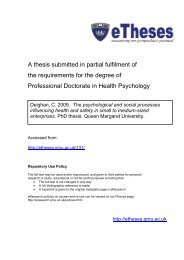A thesis submitted in partial fulfilment of - Etheses - Queen Margaret ...
A thesis submitted in partial fulfilment of - Etheses - Queen Margaret ...
A thesis submitted in partial fulfilment of - Etheses - Queen Margaret ...
You also want an ePaper? Increase the reach of your titles
YUMPU automatically turns print PDFs into web optimized ePapers that Google loves.
52<br />
develop<strong>in</strong>g a theory, usually based on the body <strong>of</strong> research that other<br />
scholars have already conducted<br />
operationalis<strong>in</strong>g the theory by develop<strong>in</strong>g hypotheses and choos<strong>in</strong>g a<br />
representative sample and a research design<br />
carry<strong>in</strong>g out the research, collect<strong>in</strong>g data and conduct<strong>in</strong>g analyses<br />
draw<strong>in</strong>g conclusions about the plausibility <strong>of</strong> the theory on the basis <strong>of</strong><br />
whether or not tests confirm the theory<br />
(Esterberg, 2006:6).<br />
Issues here arose <strong>in</strong> that, firstly, I already had a theory (the affirmative model) and, secondly,<br />
the qualitative approaches I proposed us<strong>in</strong>g did not easily match with the methodological<br />
requirements <strong>of</strong> deductive reason<strong>in</strong>g. As well as seek<strong>in</strong>g to establish the validity <strong>of</strong> the<br />
affirmative model through critical analysis, I wanted to clarify it <strong>in</strong> the light <strong>of</strong> disabled<br />
people‟s responses to cultural texts and media representations <strong>of</strong> disability. That is to say, the<br />
development <strong>of</strong> the affirmative model would rely on the data I produced through<br />
<strong>in</strong>terview<strong>in</strong>g disabled people. In Esterberg‟s words, what I wanted to create was an ongo<strong>in</strong>g<br />
dialogue between theoretical concerns and empirical evidence (Esterberg, 2002:8). This<br />
implied the necessity for mov<strong>in</strong>g back and forward between <strong>in</strong>ductive and deductive<br />
reason<strong>in</strong>g, a practice Esterberg argues is legitimate and quite common (Esterberg, 2002:8).<br />
As my th<strong>in</strong>k<strong>in</strong>g about my research developed my area <strong>of</strong> enquiry began to take the form <strong>of</strong> a<br />
question: Does anybody like be<strong>in</strong>g disabled? This seemed to me a two-sided question. If it is<br />
read from a dom<strong>in</strong>ant cultural position it could be seen as rhetorical: if disability is perceived<br />
as <strong>in</strong>dividual tragedy, the answer will likely be no, this is an experience nobody would<br />
will<strong>in</strong>gly embrace. If it is read from a perspective <strong>in</strong>formed by the social model, its mean<strong>in</strong>g<br />
is changed: if be<strong>in</strong>g disabled <strong>in</strong>volves be<strong>in</strong>g oppressed with<strong>in</strong> a disabl<strong>in</strong>g society, the answer<br />
is still no, but for different reasons. There is someth<strong>in</strong>g hidden <strong>in</strong> here, and that is the<br />
difference between liv<strong>in</strong>g with impairment and be<strong>in</strong>g disabled. When the dist<strong>in</strong>ction between<br />
these models is made, the proposition nobody likes be<strong>in</strong>g disabled is different to the<br />
proposition nobody likes liv<strong>in</strong>g with impairment. It seemed that this question afforded an<br />
opportunity to explore some <strong>of</strong> the areas <strong>of</strong> difference <strong>in</strong>volved <strong>in</strong> these two ways <strong>of</strong> look<strong>in</strong>g.<br />
I hoped the answers I might f<strong>in</strong>d <strong>in</strong> explor<strong>in</strong>g this question would <strong>of</strong>fer <strong>in</strong>sight <strong>in</strong>to ways <strong>in</strong><br />
which the affirmative model could be clarified.




